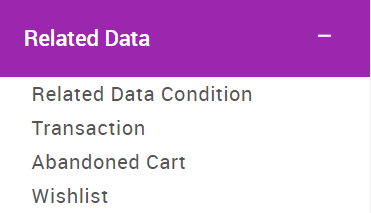Related Data
Related Data Criteria
A Related Data segment condition is based on whether or not the Related Data contains a certain value. Alternatively, a condition can be based on the number of records in a related data set for a certain user.

Related Data Condition
With the Related Data Condition criterion, you can create simple queries to related data sets. This criterion creates segments that are based on the values in the related data attributes for the contact. The logic of the segment criteria depends on the type of data that is stored in the attribute. The system offers different operators for different types of data.
| Setting | Description |
|---|---|
| Boolean | Boolean attributes contain a value true or false. The attribute can also be empty. |
| Date | Date attributes contain a calendar date. |
| Enumerated String | A string attribute can contain any characters (including letters, numbers, and special characters). Enumerated means that all possible values are defined in advance. For example, language and country are enumerated attributes. |
| Not Enumerated String | A string attribute can contain any characters (including letters, numbers, and special characters). Not enumerated means that the values are not defined in advance. For example, the standard attribute Last Name is not enumerated. |
| Number | The number data type stores data as a positive or negative numeric value. For example, a mobile number is stored as a number. Number attributes can either be enumerated or not enumerated. |
For conditions based on multiple values in the same row of the dataset, all the criteria must be defined in the same RelatedDataCondition. To define these criteria, use the Add Filter option.
Example 1
Delete contacts who have purchased a certain type of product on a certain date. The implicit logical operator here is always AND. For conditions based on multiple values that can be in different rows, define each criteria as a separate RelatedDataCondition.
Example 2
Select contacts who purchased a certain type of product AND made any purchase on a certain date. The two criteria can be true in the same row or in two different rows. In this example, OR logic can be used instead.
Transaction
The Transactions criterion works just like Related Data Condition criterion, but with predefined related data.
- orderID
- product SKU
- productName
- productPrice
- productQuantity
- returnedQuantity
- imageURL
- category
- brand
- variant
- storeID
- currency
- discountValue
- purchaseSource
Abandoned Cart
Selects contacts with certain products and/or product value in their cart.
| Setting | Description |
|---|---|
| Add Filter | Filters based on the productSKU value, and/or productPrice value. |
| In Timeframe | See Date Picker in Mapp Engage. |
| Number Of Occurrences | Filters based on the number of times the contact abandoned their cart. |
| Include contacts out of dataset | Yes/No |
Wishlist
Selects contacts with certain products and/or product value on their wish list.
| Setting | Description |
|---|---|
| Add Filter | Filters based on the productSKU value, and/or productPrice value. |
| In Timeframe | See Date Picker in Mapp Engage. |
| Number Of Occurrences | Filters based on the number of occurrences |
| Include contacts out of dataset | Yes/No |
Number Of Occurrences
This section is used to define the number of occurrences and add contacts outside the data set. There are three operators to specify how the search conditions should be applied. All these operators specify the number of occurrences the engine should search.
Operator | Description |
|---|---|
| Equals | The exact amount of occurrences should be found in the Data Set. If zero is selected - the contacts that exist in this particular datasets, but have no such records will be returned. In this case, it is also possible to include the contacts that are not presented in this particular Data Set. |
| Is Greater Than | There should be a strictly greater amount of such records in the Data Set. |
| Is Less Than | There should be a strictly less amount of such records in the Data Set. It is possible to enter any value from 2 to 999. In this case, it is also possible to include the contacts that are not presented in this particular Data Set. |